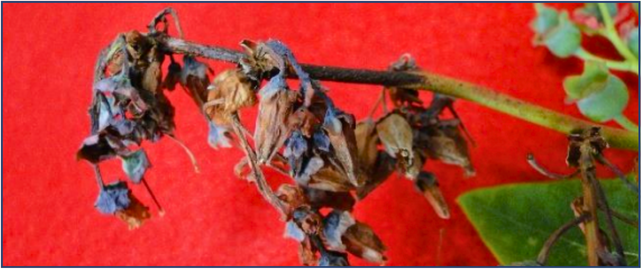It's never too early to learn about plant disease symptoms. Early detection of plant diseases is crucial to protect your crop.
What is a pathogen?
A pathogen is an organism causing disease to its host. Bacteria, viruses, nematodes, and fungi are pathogens that can cause plant diseases. Pathogens enter their host and seize the plant’s energy for their use. Pathogens can enter a plant in various ways, including wounds or natural openings, penetrating plant tissue, mechanical damage, or insect transmission.
What is a disease cycle?
A disease cycle is a series of events involved in disease development. In most disease cycles, the basic steps are inoculum production, the spread of inoculum to a susceptible host, penetration of inoculum into a host, infection, secondary cycles, and pathogen survival between host plants.
Why is identification vital?
Identifying pathogens is the first step in controlling plant diseases and producing quality crops. Proper identification is necessary to implement effective management strategies.
Anthracnose Fruit Rot
The fungus Colletotrichum acutatum is responsible for anthracnose fruit rot. Colletotrichum gloeosporioides may also be found on blueberries in the southern United States.

Photos courtesy of Margaret McGrath, Cornell University
Symptoms
It primarily damages fruit but may also infect twigs and spurs. The fruit surface will develop salmon or rust-colored ooze, which contains spores. Blossom clusters may turn brown or black. Young, girdled stems die back, resulting in a brown withering of the leaves. All infected plant parts will become covered in gray mold in damp conditions. Fruit rot symptoms usually do not appear until the fruit ripens; berries that look perfectly healthy at harvest can rot soon afterward. Infected berries eventually shrivel up and fall off the bush.
Disease Cycle
This disease favors cool, muggy weather and often occurs post-harvest. The fungus overwinters on infected plants and plant debris. Spores are spread by wind or water.
Phomopsis Twig Blight and Canker
The fungus Phomopsis vaccinii causes Phomopsis twig blight and canker.

Photo courtesy of Chris Smigell, University of Kentucky
Symptoms
Symptoms include tip dieback on infected wood, and infected buds will become brown and die. Cankers on stems or in the crown may form and kill the stems. Spores may be visible on blighted twigs and at the base of the cane. The disease will travel into the stem and cause sudden wilting and death of canes. Leaves will change color to red or brown. This disease may also cause fruit to rot at the time of harvest.
Disease Cycle
This disease overwinters in infected plants. This disease primarily affects one-year-old woody stems with flower buds. Spores are produced and released during rainy periods.
Botrytis
The fungus Botrytis cinerea causes Botrytis blight.

Photos courtesy of Dr. Yonghao Li, The Connecticut Agricultural Experiment Station
Symptoms
Botrytis may affect leaves, blossoms, fruit, and green tissue. Shoot tips will die and turn brownish-black and, after time, will turn a lighter tan or gray color. Blossoms that become infected will turn brown and appear water-soaked. Immature fruits may shrivel and turn purple, while mature fruits appear tan. When wet conditions are present, infected plants will have rotted flowers and berries covered in gray fuzz and spores.
Disease Cycle
The fungus favors cool, humid weather. This disease can overwinter on infected plants, and spores can be spread by wind.
Mummy Berry
The fungus Monilinia vaccinii-corymbosi causes Mummy Berry.

Photos courtesy of Bill Cline, NC State Extension
Symptoms
This disease impacts leaf shoots, berries, and flower buds. The first visible sign of this disease is “mummy cups” on the ground near the blueberry bush. After a few weeks of the emergence of the cup-shaped structures, new shoots and leaves will wilt, and the wilted shoots will have brown discoloration. Infected plant parts will become covered with fungal spores that appear powdery. Once the infection moves to the berries, the plant will produce a “mummy” berry, a pink-colored berry with hard, soft skin and white fungal growth inside. These berries will fall to the ground and become the initial source of infection the following year.
Disease Cycle
This fungus is most severe after moist spring weather. The fungus overwinters on the infected, fallen “mummy” berries. In the spring, the mummies release spores that infect new growth. Insects may carry the spores to open flowers. The fungus will inhabit the flower ovaries.
Reminder
Nourse Farms is here to help your plants survive and thrive! Call us at 413-665-2658 or email us at info@noursefarms.com if you have any questions.
Resources
Blueberries. “Michigan Blueberry Facts: Anthracnose Fruit Rot (Ripe Rot) - Blueberries,” n.d.
“Mummy Berry Disease of Blueberry | NC State Extension Publications,” n.d.
Photo Resources:
Gauthier, Nicole, and Chris Smigell. “Blueberry Cankers & Twig Blights.” University of Kentucky College of Agriculture, Food & Environment Extension Plant Pathology, January 2022.
Li, Yonghao. “Botrytis Blight of Blueberry.” The Connecticut Agricultural Experiment Station, January 2023.
“Mummy Berry Disease of Blueberry | NC State Extension Publications,” n.d.




